Steven Lyle Jordan's Blog, page 20
October 25, 2016
Replacing rockets to orbit

I recently came across a study at the University of Colorado at Boulder that revealed rocket exhausts are damaging to the ozone layer. Although their impact is presently small—since, hey, we don’t launch that many rockets—as we expand our activities into space, we have to consider the future impact all of those rockets will have on our biosphere. That means it’s time to think about alternatives to rockets.
Fortunately, science (and science fiction) has provided us with a lot of ideas to kick around; and as we talk about near-term orbital facilities, way-stations for longer voyages and even tourist trips, now is the time to start the conversations and start planning for a better future into space.
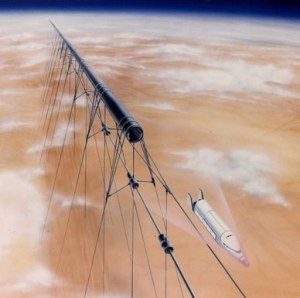 My personal favorite, out of all the proposed or possible systems, may be the idea often referred to as a Rail Gun. Though the name suggests an archaic system ala Jules Verne, a rail gun wouldn’t use explosives to move its payload… it would use modern electromagnetic systems (maglev) to pull a payload to a high velocity and release it, allowing the payload to continue into space either on its own momentum or with assistive technology (rockets).
My personal favorite, out of all the proposed or possible systems, may be the idea often referred to as a Rail Gun. Though the name suggests an archaic system ala Jules Verne, a rail gun wouldn’t use explosives to move its payload… it would use modern electromagnetic systems (maglev) to pull a payload to a high velocity and release it, allowing the payload to continue into space either on its own momentum or with assistive technology (rockets).
A maglev system is not only powerful enough to accelerate a payload to an incredible velocity, but it can do so much more efficiently than a chemically-fueled booster rocket, allowing a significant savings in materials and weight for the overall payload. Such a system could have launched the Apollo 11 spacecraft and done without the Saturn V booster that was the most significant single element of the launch, used less raw energy doing it, and would’ve significantly cut down on the pollution factor (if the rail gun was powered by clean energy).
A further advantage to a rail gun is the lack of vibration impacting the payload, compared to the thunder and vibration of being strapped to a booster rocket. Violent vibration has been known to damage payloads, flight and propulsion systems, and has been the direct cause of some of the most disastrous rocket failures in history. Payloads have to be built extra-resilient to survive the rough flight to orbit, which makes them more expensive (and heavier). Using a rail gun system would result in a much smoother transition to orbit, allowing payloads to be lighter and less expensive.
There have been a number of design concepts for maglev systems, but I think keeping it as simple as possible is the best approach. I’d advocate a straight track, extending on a tower as far as possible into the atmosphere, in order to build up as much payload speed as possible at a reasonable acceleration rate (too many Gs of acceleration can destroy your payload). I suspect such a tower and rail would be most efficient if it was as vertical as possible, and launching close to vertical would mean less atmosphere to travel through to get to orbit, reducing drag. On the other hand, launching at less than vertical would allow the payload to take advantage of air-fed propulsion, such as aerospikes, to build velocity and achieve orbit; there would be advantages to that system, such as better control over the launch window, that may be worth pursuing.
 SF people love to talk about the possibilities of building and operating a Space Elevator, a structure that will run from ground all the way into orbit and allow people and cargo to transit back and forth, also using a maglev system, more efficiently than with rockets. However, I have serious doubts about the practicality of such a venture, primarily due to the incredible difficulties of actually running the cable/tower/structure from Earth to orbit (35,000 kilometers!), maintaining it and suppressing natural forces (like vibration, pressure and possible impacts). I’m not saying it’s actually impossible… but it may be beyond the technical capabilities of Mankind to accomplish, in the relatively near future or… ever.
SF people love to talk about the possibilities of building and operating a Space Elevator, a structure that will run from ground all the way into orbit and allow people and cargo to transit back and forth, also using a maglev system, more efficiently than with rockets. However, I have serious doubts about the practicality of such a venture, primarily due to the incredible difficulties of actually running the cable/tower/structure from Earth to orbit (35,000 kilometers!), maintaining it and suppressing natural forces (like vibration, pressure and possible impacts). I’m not saying it’s actually impossible… but it may be beyond the technical capabilities of Mankind to accomplish, in the relatively near future or… ever.
Though we may not be able to build a space elevator all the way to orbit, or even a few dozen miles high, it should be within our technological capabilities to build a tower at least a few miles tall… enough to get through a significant part of Earth’s lower atmosphere. If a system was built tall and powerful enough to get even heavy payloads into orbit… great. If not, rockets could still provide the added push to get to orbit, but they could be much smaller and lighter (and, by extension, less dangerous) than a heavy booster… by comparison to a Saturn V, it would be like using only the third stage of the booster. And if technology improves over time, we could expand the tower until it was tall and powerful enough for its payloads to reach orbit.
We have yet to see a serious attempt to build and test a rail gun launch system, but the technology is advancing rapidly enough that it may be attempted soon. If it succeeds, we’ll see a new alternative to monstrous booster rockets to orbit, and hopefully a significant financial (and environmental) saving for each launch.


October 13, 2016
Will personal cars go away?
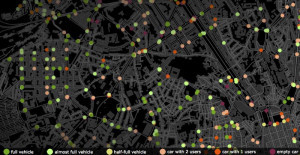 A recent simulation created by the Organization for Cooperation and Development, based on traffic and commuter patterns in Lisbon, Portugal, suggested that automated taxis could become so efficient that 90% of personal cars could be taken off the roads. Percentages may vary according to country and driving habits (and the U.S. is so much larger than most European countries that the data may be wildly different here), but the conclusion is clear: Automated vehicles could render a great majority of our personal cars obsolete.
A recent simulation created by the Organization for Cooperation and Development, based on traffic and commuter patterns in Lisbon, Portugal, suggested that automated taxis could become so efficient that 90% of personal cars could be taken off the roads. Percentages may vary according to country and driving habits (and the U.S. is so much larger than most European countries that the data may be wildly different here), but the conclusion is clear: Automated vehicles could render a great majority of our personal cars obsolete.
But does that mean that personal cars will actually go away? In the U.S., I have my doubts, at least in the short-term.
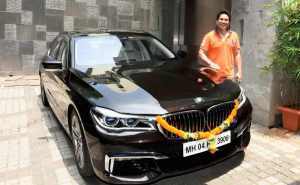 Much of this doubt comes from the well-known American love-affair with its vehicles. Americans don’t just depend on vehicles to get around… we do more to decorate, personalize, display, show off and compete with other vehicles than any culture on the planet. Cars become an extension of our personalities, like our clothing, hair style or tattoos. Asking Americans to give up their cars would be asking them to give up part of how they define themselves.
Much of this doubt comes from the well-known American love-affair with its vehicles. Americans don’t just depend on vehicles to get around… we do more to decorate, personalize, display, show off and compete with other vehicles than any culture on the planet. Cars become an extension of our personalities, like our clothing, hair style or tattoos. Asking Americans to give up their cars would be asking them to give up part of how they define themselves.
We also travel a lot from populated area to populated area, and are fully used to traveling when we are ready, not when a transportation schedule tells us we can go. That innate sense of time freedom is also hard to get rid of, and the reason our bus and train industries aren’t doing so much better on American streets and transportation corridors.
And there is another factor… one that isn’t often discussed by the layman, but an important psychological finding that U.S. automakers have depended on for decades. When, in the 1970s, America was in an oil crisis, and people were under pressure to buy smaller, more gas-efficient vehicles, the Detroit automakers hit upon a selling strategy that still impacts American buying today: They strapped upscale designs and materials on their cheapest-to-make vehicles, the small truck—which were also regulated differently than cars, and didn’t have to be as gas-efficient as government standards for cars demanded; they repackaged these cheap-to-make trucks as luxury “Sport Utility Vehicles” and, using commercials to appeal to our sense of entitlement and machismo, sold these vehicles like gangbusters (and, conveniently, made a mint themselves).
When you combine these factors, you see a clear trend towards ownership-by-entitlement, significant customization and freedom to drive whenever the urge strikes. This trend has encouraged many people to spend more on personal transportation than they spend on good food, housing, clothing and any other possessions.
 And I suspect the automated car era will not curtail this trend significantly in the U.S. for quite some time. Consider the automated vehicle, the robo-taxi: Sure, it’s available to get you where you want to go; but will it get you there in the style in which you’re accustomed? Whereas, if you owned your own automated vehicle, you could customize it inside and out, include your personal style of lounge seating, a bar of your favorite drinks (hey, you’re not driving, so why not have some drinks?) and personal entertainment. In these vehicles, rolling parties of 2-6 people could become popular forms of entertainment… maybe you’ll get some reading or work done during your trips… or maybe vehicles will be optimized for a little shut-eye along the trip.
And I suspect the automated car era will not curtail this trend significantly in the U.S. for quite some time. Consider the automated vehicle, the robo-taxi: Sure, it’s available to get you where you want to go; but will it get you there in the style in which you’re accustomed? Whereas, if you owned your own automated vehicle, you could customize it inside and out, include your personal style of lounge seating, a bar of your favorite drinks (hey, you’re not driving, so why not have some drinks?) and personal entertainment. In these vehicles, rolling parties of 2-6 people could become popular forms of entertainment… maybe you’ll get some reading or work done during your trips… or maybe vehicles will be optimized for a little shut-eye along the trip.
This is what I would expect as many Americans as can afford it will do: Buy a vehicle, personalize its interior and exterior to be an extension of their home lifestyle, and roll around in their own four-wheeled family room. And they wouldn’t want to loan out their vehicle, at least not except to very close friends or relatives, for fear of strangers mucking up their extended home… so there would still be a lot of cars out there, personalized private vehicles and boring public vehicles sharing the (probably still crowded) roads.
Maybe as time goes by, Americans may start to lose their love affair with the automobile; some think that the desire to own a vehicle you can’t actually drive will wane, while others may decide they’re okay with having one less personal property (and financial) burden on their hands. And if public vehicles start to be designed with more luxurious interiors, the need of entitlement-ownership may eventually fade as well. (BYOB will probably remain a thing.) But I expect automated vehicles will be sharing American roads with personal vehicles for some time to come.
Download the simulation report from the OCD.


October 10, 2016
Time for political change
 This year’s presidential elections have done a fantastic job of demonstrating all the problems with our current electoral system: Republicans have acted in lockstep defiance of anything coming out of Democrats’ mouths for so long that they absolutely refuse to agree in public with anything Democrats propose. If, at this point, the Democrats proclaimed that the sky was blue, the Republicans would talk themselves into a stroke arguing that it was, in fact, periwinkle or ultramarine.
This year’s presidential elections have done a fantastic job of demonstrating all the problems with our current electoral system: Republicans have acted in lockstep defiance of anything coming out of Democrats’ mouths for so long that they absolutely refuse to agree in public with anything Democrats propose. If, at this point, the Democrats proclaimed that the sky was blue, the Republicans would talk themselves into a stroke arguing that it was, in fact, periwinkle or ultramarine.
As a result of this “anti-Democrat” stance, they’ve allowed the nomination of Donald Trump, a racist, misogynist, selfish, failing businessman who stands for none of the values of the party beyond “all the money for me” (and let’s be honest: It’s only because that stance is so entrenched into Republican dogma that it’s taken them so long to finally denounce the idiot). Yet, even though they now denounce their own candidate, they can’t replace him… and they won’t actually go so far as to tell the American people to vote for the Democratic candidate, Hillary Clinton. “He’s a moron… but he’s ours, and he’s still (somehow) better than her” seems to be their current attitude..
And as undesirable as the two choices may be to many voters, there are no other real choices, as the system effectively blocks candidates of other parties from having a real shot at the presidency by limiting their possibilities of exposure with the American public, as well as organizing an electoral college system that is unfriendly to third parties.
However this election comes about, I hope that it will serve as a clarion call for the people and our government to accept that our present government system, based on the ideals of men 200 years our seniors, is long overdue to be brought into the 21st century where it belongs.
I’ve spoken on this subject before: My primary argument is that the overall format of our government, including our election process, is based on the world of 1776, when we traveled about on horseback, it took weeks to travel between Boston and Washington, and many American citizens heard about the latest news perhaps months after it happened. Our communications technology has improved enough in that time that the weeks and months of time we’ve baked into many of our processes can effectively be limited to days. We should restructure that system to take into account these advances.
We’ve also barely progressed beyond paper ballots and simple identification systems. ID technology, especially biometrics, and computer-based, redundantly-verified tabulation systems must be brought fully to bear on the voting system itself, allowing the system to tabulate results in realtime, and allowing voters to vote in a localized polling place, in their homes, or even via cellphone from anywhere in the world. As with communications technology, we have the digital and ID technology to put a new system in action today.

You could consider this either a third-party candidate or the American people… you decide.
Also, we’ve allowed our electoral system to form into two overriding parties that are now powerful enough to control the electoral process itself… including making it nearly impossible for other parties to have the same opportunities that the two major parties have. This was never intended by our founding fathers, as it puts too much power in the hands of the majority players and literally shuts out minority parties from equal participation. As many of us now see that neither of the two parties represents us well, it’s time to rewrite electoral process to make sure multiple parties have equal opportunity to represent themselves to the people, giving them a fair shot at being elected.
Conjoined to this is the role the news media plays in the electoral process: Essentially influenced or outright controlled by the major parties, or driven by sponsor-based sensationalism, the news media plays a ratings-popular but ultimately inane “us-against-them” program, even avoiding informed review of the process in favor of headline-grabbing sound bytes and titillation-factor comments by celebrities and people on-the-street who know nothing about politics and less about political figures. The media has turned the news into a ratings-driven three ring circus; it’s time to close that circus and divorce news from sensationalist media, so we can again depend on our news reporters to do the job of accurately reporting the news to the public.
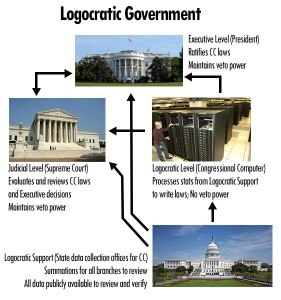 But perhaps most importantly, I believe it’s time for us to move to a new overall system of government that utilizes computers to collect and tabulate data from every state, and writing laws based on that data. My earlier post details the structure of a Logocracy, wherein the computer system would essentially replace the human representatives in Congress and the Senate, repurposing the congressional staff to ordering and collecting the data for the logocratic computer system. Updating our present government system into a 21st century structure, one that can keep track of the ever-complex and ever-changing needs of our country much better than politicians more interested in lobbyists’ “donations” than in the good of their country, is long overdue, and—with the existence of modern computers—now possible and desirable.
But perhaps most importantly, I believe it’s time for us to move to a new overall system of government that utilizes computers to collect and tabulate data from every state, and writing laws based on that data. My earlier post details the structure of a Logocracy, wherein the computer system would essentially replace the human representatives in Congress and the Senate, repurposing the congressional staff to ordering and collecting the data for the logocratic computer system. Updating our present government system into a 21st century structure, one that can keep track of the ever-complex and ever-changing needs of our country much better than politicians more interested in lobbyists’ “donations” than in the good of their country, is long overdue, and—with the existence of modern computers—now possible and desirable.
Maybe my outline wouldn’t be the best next step in American government… maybe you think some other system would be better. But what’s important is that now is clearly the time to open discussions on the issue, while the wrecked heap of twisted metal that is our present government system is still smoldering before us. Because I don’t know about you, but if I knew our next presidential elections were going to look as bad as this year’s elections, I’d be making sincere plans to move to Aruba.


October 7, 2016
The unthinkable has happened.
 So, some of you who’ve been here before are aware that I haven’t been doing any writing in a few years, and have sidelined my book sales until/unless I can find a workable way to promote them and get some significant sales happening. And so I’ve been for the past few years, and mostly okay with it.
So, some of you who’ve been here before are aware that I haven’t been doing any writing in a few years, and have sidelined my book sales until/unless I can find a workable way to promote them and get some significant sales happening. And so I’ve been for the past few years, and mostly okay with it.
But now… the unthinkable has happened.
I want to write.
I’m in a position I haven’t been in for quite some time, wherein I have an idea that I think might even be good. In the last three years I’ve made sure good ideas that blossomed in my brain received absolutely no watering or tending, so they’d die on their own. But this one grew anyway, much like a weed. I have some really basic preliminary concepts together, and I’m considering fleshing them out until I have the makings of a novel to write. And the part of me that enjoyed the process of developing and writing a novel wants me to go for it. That side of me figures I’ve stayed out of writing long enough, and it’s time to get back on the horse and gallop.
Problem is, the practical side of me is still standing there like an immovable object, saying: “Not so fast. Did it really take you only three years to forget about all the work you did on thirteen books that got no traction at all? Do you really want to start up that colossal no-profit time-waster again? Wouldn’t you rather go learn carpentry or paint your house or something?”
So I’m mentally standing here, considering whether I should push practical me aside… or if I should go find some paintbrushes instead.
So many writers I either know, or have heard speak, like to say that when you have the writing bug, you must obey it, no matter what. They encourage people to just write, even if they really can’t write worth a damn, because what’s most important is the actual process of writing, the satisfying of your muse, and the story holes can be fixed (by you or an editor) later. They also tend to imply that if you don’t or won’t just write when the muse strikes, then you’re not really a writer, are you?
Part of me just laughs at this… as if there is really only one kind of writer… as if there aren’t any number of professional writers, including best-selling writers, who wouldn’t give it all up and find a job at the local university or hardware store if they knew that they’d never make another dime from writing. As if there are no amateur writers who have walked away in the middle of a chapter, because it was time to go earn a real living to pay their mortgage or buy their child’s shoes. But part of me gets a bit incensed at the attitude, the suggestion that writers are somehow extra-special, artistic giants among men, something that I have to measure up against, and will surely be found coming up short.

Shut up, stupid Muppet.
And all of me wonders whether it’s worth the trouble to do all that work, only to see single-digit-per-year sales. And be assured, at this point every moment I work on a book is accompanied by a voice in the back of my head, whispering: “No one will read this, stupid. No one.” Seriously. I listened to that voice during the entire production of my last three books. I’m kinda sick of that voice. Which makes me wonder whether I’m better off with the paintbrushes than I am in this hoi-polloi fraternity of Writers for Nothing.
So you know, I’m not looking for any kind of an answer from anyone who’s reading this; ultimately, I will either do it or not, but it won’t be because of something thrown into the comments section to inspire or devastate me (too late—nyah). I just felt like unloading a bit, mainly so people will hear from the other kind of writer… the kind who is loathe to waste his time.


September 26, 2016
Time to decentralize the nation’s power grid
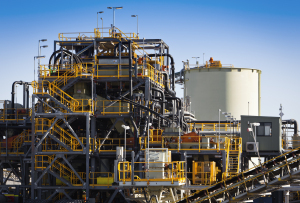
Two unexpected failures of power plants in Texas brought the state power grid to its knees during the massive winter storm that hit at the beginning of January.
Back when the US was building its infrastructure (over a century ago), our technology was on a centralized power kick: It was far cheaper, easier and more efficient to build one big power plant and send its power across the lands via wires, vs putting smaller power plants on every other block. Made sense.
But today, we are hugely dependent on power for everything we do, and we’re using more of it than ever, putting severe strain on our energy grid. And in today’s world of terrorists, 100-year weather events every 2 years, fracking-induced earthquakes and ancient, ready-to-fail equipment, putting all of our eggs in one basket just doesn’t make the sense it used to.
The time has come for the US to decentralize its power grid, and start taking advantage of modern technology to allow every home to power itself.
Centralized power, with all of its upsides, has incredible downsides when it goes bad. Not only can bad weather conditions cause widespread failures—and thanks to climate change, our weather is getting worse every year, severely taxing our systems—but the centralized power plant is a single-point target for regional disruption, making them military targets. Even more serious, our power grid is so interconnected in a fragile web that losing even one node can create a cascade failure that overloads and takes down plants that provide power to multiple states. Terrorists are already probing our nation’s networks, seeking ways to shut down our power grid. This is a system that’s no longer safe to depend on; it’s only a matter of time before our power systems get “hit” by terrorists, enemy attackers or just plain catastrophic weather, leaving us all in the dark and bringing life and business to a standstill.
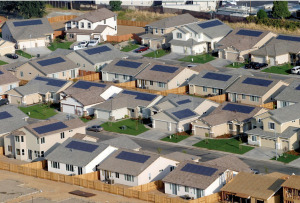
A subdivision of homes outfitted with photovoltaic panels for energy generation.
But we are now in the position of being able to evolve our power network into a smarter, decentralized system that will be more sophisticated and far less vulnerable to attack. Using today’s photovoltaic products, which are now cheap enough to install on the property or the roof of almost any home, we can start producing enough electricity to supply an individual home’s daily needs. Solar power has become the primary technology making individual power systems workable. Other power generation technologies include wind and water power, if you have adequate access to wind and water sources. Where possible, a single home can combine as many of these as are convenient.
The other technology that makes these individual power systems workable is battery technology, which is similarly evolving in storage and cost, and perhaps represents the real decentralized power game-changer. A rooftop solar panel, for instance, can generate significant power and store it in the battery during the day when no one is home; then the battery will release that power later, when the family returns from work and school. Individual buildings and homes can meter their need for power and storage on an individual basis, and excess or waste power generation, transmission loss (as heat) and consumption is lessened. And in cases where individual home power generation is still not effective, small community systems can still be constructed and shared by small groups of homes or businesses. At the very least, each home can still have a battery, storing power until needed during a blackout or other emergency.
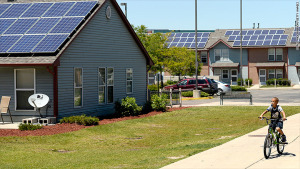 These systems make homes and businesses their own power generators, and less (or no longer) dependent on the centralized grid for day-to-day power. Imagine hearing on the news that a terrorist act or a sudden flood has managed to disable your power company’s local plant; yet, your house is still powered, perhaps running off of battery power, enabling you to hear the news, or take whatever appropriate action to be safe. Businesses can still operate, having access to their own digital data, or make unhurried plans to shut systems down safely and properly. Power is still there where needed.
These systems make homes and businesses their own power generators, and less (or no longer) dependent on the centralized grid for day-to-day power. Imagine hearing on the news that a terrorist act or a sudden flood has managed to disable your power company’s local plant; yet, your house is still powered, perhaps running off of battery power, enabling you to hear the news, or take whatever appropriate action to be safe. Businesses can still operate, having access to their own digital data, or make unhurried plans to shut systems down safely and properly. Power is still there where needed.
Power companies would obviously be seriously impacted by decentralization, since they are built on a centralization strategy; but altering their business models from one of pumping out centralized power to one of supporting decentralized power installation and support would allow them to take part in the evolution to decentralization. (This would also allow them to overcome the growing public relations perception of them as monopolies, profiteers and security liabilities.)
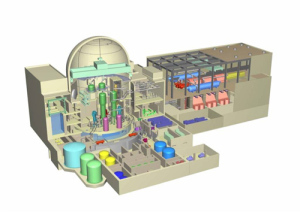
Layout of a thorium-fueled nuclear power plant.
Decentralization would reduce the need for new power plants, especially coal and nuclear plants that aren’t very popular in populated areas. In some cases, ageing and soon-to-be-decommissioned plants can be replaced by smaller power systems designed to augment the power grid, as opposed to having to provide all of the grid’s power. Being able to use smaller plants will make it feasible to apply alternative technologies to power plants, such as solar, wind, tidal and geothermal systems; as well, we can replace our first- and second-generation plutonium-fueled nuclear plants with safer, cleaner thorium plants. Decentralization would go a long way to improving our environment through the lessened use of dirty technologies powering our grid.
Finally, there would be significant retooling of the network itself; but better that’s done by the owners of the infrastructure than outside organizations that won’t know the system as well. All that solar panel installation and support would also make for a great nationwide work program, proving a lot of jobs and cutting down on national unemployment.
Today the benefits of decentralized power generation outweigh the benefits of centralized power, perhaps for the first time since the start of the Industrial Revolution. The US is in a position to be able to put its people to work and roll out solar panels for every home, putting us on a fast-track to power decentralization, and we should start immediately, in the name of home (and Homeland) safety and security.


September 19, 2016
Respect
 We’re celebrating the long-overdue Emmy win by Tatiana Maslany for her total dominance in playing, in some episodes, as many as a half-dozen different characters, all clones, in the incredible series Orphan Black. And at the same time, rejoicing in Rami Malek’s best lead actor win for the first season of Mr. Robot. Both wonderful and much-deserved wins for some incredible actors. I raise a toast to Tatiana and Rami!
We’re celebrating the long-overdue Emmy win by Tatiana Maslany for her total dominance in playing, in some episodes, as many as a half-dozen different characters, all clones, in the incredible series Orphan Black. And at the same time, rejoicing in Rami Malek’s best lead actor win for the first season of Mr. Robot. Both wonderful and much-deserved wins for some incredible actors. I raise a toast to Tatiana and Rami!
Then I get to the lemon in the cocktail: When this morning’s national news media reported on last night’s Emmy wins, they singled out Veep, The People vs. OJ Simpson, Game of Thrones (of course) and a few other mainstream productions. But it seems Best Lead Actor in a Drama series and Best Lead Actress in a Drama series weren’t worth bothering to mention to the general public this year.
And yeah, this gets my goat. In what some are considering a new golden age of television, two TV series—outstanding works by any measure, but that just happen to be serious science fiction—get dissed. It took four years for Tatiana to be recognized for her amazing work playing multiple characters at the same time in every single episode, with the unparalleled production that is Orphan Black, which includes excellent writing and flawless special effects. Mr. Robot, a much quieter but equally compelling series, was recognized after its first year, which is almost as rare as being recognized for SF in the first place.
But when it comes to lauding them in the mainstream news, they were blown over in favor of big-profiting favorites. Other than the few obligatory “The best shows you’re not watching” articles here and there, you won’t be hearing a lot of talk about Orphan Black or Mr. Robot at the water cooler today. More likely, you’ll be discussing Louie Anderson or Julia Louis-Dreyfuss. Or maybe—just, just maybe—why Keri Russell gets no love for her phenomenal role in The Americans.
After we just saw the premature ending of Person of Interest this last season, it’s downright painful to see the short-shrift and disrespect serious science fiction television gets, especially from its own industry peers. It seems only over-the-top violent or salacious content is good enough to get noticed by television executives (and don’t get me started by the fact that the final episode of Person of Interest featured a lead character getting taken out by frikkin’ drone missiles)… I’d be willing to bet the removal of that kind of content would have assured Game of Thrones would have lasted no more than two seasons. Even the Syfy channel has pretty much given up on serious SF content in favor of space opera and silly horror films.
And it goes along with the current trend of adding ridiculous action scenes, cheap melodrama and needless skin and nudity to science fiction movies like Star Wars and Star Trek, while completely forsaking anything that even hints of a serious scientific treatment, and promoting these dogs ad nauseam over much better science fiction like Ex Machina, The Martian or Interstellar.
It hurts to see such incredible performances and groundbreaking work being shoved behind the curtains, like bastard children whose successes the media would rather hide. Because of this, I have shrinking confidence that the new HBO series Westworld will be recognized for the ground-breaking psychological and morality drama that it is being molded into, nor seen as anything other than a new excuse for the violence and hedonism that Game of Thrones has provided. (I do think Westworld will be a great show; I just have serious doubts that it will be given its due by the industry.)
And it’s not just my sour grapes: Consider that quality talents notice that the SF genre is constantly given the cold shoulder, which impacts the likelihood that their work will be recognized, which affects their hire-ability and potential salaries. Which means fewer of them will want to work on SF shows, bringing down the quality of all SF shows.
So, unless we want all SF to be cheap knock-offs of Star Wars, we should all be concerned about the media’s ignoring of our favorite genre. #RespectSeriousSF, people.


September 7, 2016
Star Trek: 50 years of good and bad
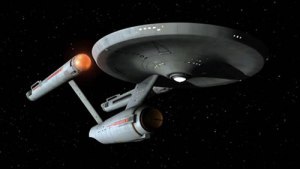 Wow. Fifty years ago, a new idea for a television show aired: A science fiction vehicle based on a western concept (“Wagon Train in space” was the pitch), framed around a United Nations-type organization, set on a para-military ship that sailed the cosmos the way American battleships bumped around the islands of the Pacific, using idealized future versions of modern technological concepts, depicting aliens as thinly-disguised nationalities of humans, and telling morality tales couched in melodramatic adventure stories. Before this, the big science fiction concept in movies or television had been Forbidden Planet (and you can clearly see its influences). Before that, Buck Rogers and Flash Gordon serials… both running the mid-afternoon loops on local TV stations when this new show arrived. And before too long, Flash and Buck lost their mid-afternoon slots to this new show, one of the very first darlings of syndication.
Wow. Fifty years ago, a new idea for a television show aired: A science fiction vehicle based on a western concept (“Wagon Train in space” was the pitch), framed around a United Nations-type organization, set on a para-military ship that sailed the cosmos the way American battleships bumped around the islands of the Pacific, using idealized future versions of modern technological concepts, depicting aliens as thinly-disguised nationalities of humans, and telling morality tales couched in melodramatic adventure stories. Before this, the big science fiction concept in movies or television had been Forbidden Planet (and you can clearly see its influences). Before that, Buck Rogers and Flash Gordon serials… both running the mid-afternoon loops on local TV stations when this new show arrived. And before too long, Flash and Buck lost their mid-afternoon slots to this new show, one of the very first darlings of syndication.
That was the beginning of the phenomenon that is Star Trek, which we celebrate in its 50th anniversary this year. But if you were expecting a few pages of praise or diatribe about the show and its concurrent universe of assorted detritus… nah. Everyone’s doing that.
Instead, I’m just going to post a personal list of all the things I can think of, good and bad, that have been part of the Star Trek experience.
Good: The inspiration of Star Trek, firing the imagination of kids and adults, dreamers and engineers, writers and artists, and science fiction lovers everywhere.
Bad: Star Trek was, after all, a TV show designed to sell soap every week, and as good as it was, it could have been better if not for the narrow-mindedness of TV executives.
Good: A ship’s crew that represented most of the nationalities of America’s “melting pot.”
Bad: Aliens that were pretty much two-dimensional caricatures of non-American nationalities… with one exception…
Good: Spock. Half-human, half-Vulcan, 100% fascinating.
Bad: Almost all the other Vulcans we met tended to be dicks. Just sayin’.
Good: Exploration of the Final Frontier: Very noble and exciting.
Bad: Cold War-style conflicts with aforementioned two-dimensional alien caricatures.
Good: Using science fiction to tell allegorical morality tales.
Bad: Allegorical explorations of the human condition sometimes got… very silly.
Good: Extrapolation of modern technology gave us communicators, diagnostic beds, tricorders.
Bad: Sci-fi TV budgets and limitations also gave us phasers, transporters, warp speed and ships that rock when fired upon.
Good: Mining the theater for talents capable of handling high concepts and melodrama.
Bad: Judge Melvin Belli. (“Death to you all!”)
Good: The original write-in campaign to save Star Trek after 2 seasons of low ratings.
Bad: Putting season 3 in the Friday night Death Slot.
Good: The Doomsday Machine, my personal favorite TOS episode.
Bad: Spock’s Brain. Pew.
Good: Syndication. Most Trek fans today never saw the original run, and only discovered the show’s awesomeness through syndication.
Bad: Syndicated runs often edited out the show’s more cerebral and character-driving moments to make time to sell more soap.
Good: Star Trek novels. Lots of incredible content.
Bad: Star Trek: The Animated Series. Lots of horrible flat animation.
Good: Star Wars. Yes, its surprise commercial success convinced Paramount to revive Star Trek.
Bad: Now every sci-fi feature has to be like Star Wars to satisfy producers and audiences. There go the high-minded morality tales.
Good: The refit Enterprise in Star Trek: The Motion Picture. Like seeing a beloved cousin for the first time in years, now all grown up and ravishingly beautiful.
Bad: Blowing it up in The Search for Spock. Like watching my cousin being murdered.
Good: The Undiscovered Country.
Bad: Misquoting Melville (and many, many other things) in The Wrath of Khan.
Good: Star Trek reboots as The Next Generation.
Bad: That first season or so. Could we have Flash Gordon back?
Good: TNG seasons 2.5-on.
Bad: Wesley Crusher, Gene Roddenberry-as-a-boy surrogate and all-around pest (until he left for Academy, anyway).
Good: Holodecks.
Bad: Holodecks.
Good: The Borg, scary merging of organics and technology.
Bad: The Ferengi, pretty much capitalist man-monkeys when first introduced.
Good: Discovering the Federation was far from perfect.
Bad: Discovering Enterprise crew members are still racist (well, speceist) and clonophobic.
Good: Stories that explore serious scientific concepts.
Bad: Time travel.
Good: Family.
Bad: Rascals. Pew.
Good: Worf develops from caricature to character over 5 seasons.
Bad: Then he’s given a brat of a son.
Good: Deep Space Nine, the best of the TV series.
Bad: DS9‘s first episode.
Good: First substantive stories of non-military life outside of a Federation starship.
Bad: Not enough of it.
Good: Ferengi get developed into real characters at last.
Bad: Cardassians pretty much remain two-dimensional villains.
Good: Garak’s spy cat-and-mouse with Bashir.
Bad: Morn. Cheap laugh.
Good: Religion finally becomes a story idea.
Bad: Religion eventually becomes political bickering point.
Good: Space station, not another starship.
Bad: Least Star Trek-looking of all the series.
Good: Holosuites.
Bad: Holosuites.
Good: The Defiant.
Bad: Endless Federation-Klingon-Romulan-Cardassian-Dominion wars.
Good: Worf and Dax. (Woax? Darf?)
Bad: Worf dumping Dax when Dax got a new body. Bad form, dude.
Good: Star Trek: First Contact.
Bad: Star Trek: Nemesis.
Good: Captain Kathryn Janeway.
Bad: Neelix.
Good: Stuck in the Delta Quadrant.
Bad: Apparently wasn’t that hard to stay supplied on the way.
Good: Year of Hell.
Bad: Complete reboot at end of Year of Hell.
Good: Seska.
Bad: Kazon (what were they, outer space gangs?).
Good: More Borg.
Bad: Seven of Nine, blatant nerd porn.
Good: Memorial.
Bad: Threshold.
Good: Star Trek: Enterprise‘s depiction of the first warp-capable Earth ship.
Bad: Everything else about Enterprise.
Good: J.J. Abrams casts Zachary Quinto as Spock in the new movies.
Bad: Everything else about the new movies.
Good: Announcing a new Trek series.
Bad: Putting it on a barely-watched pay-per-view internet channel instead of broadcast TV.
And there you have it, my list of good and bad in the Star Trek universe. Feel free to quibble, but this is my list, after all; if something doesn’t sit right with you, don’t take it personally. (Translation: No Wrath of Khan rebuttals—I mean it.)


August 31, 2016
Weird place
 That’s me, right now: In a weird place. Weird because I’ve just written a blog post that (for me) has been pretty popular—so far about 430 views in the past 48 hours—and I’m disappointed about it.
That’s me, right now: In a weird place. Weird because I’ve just written a blog post that (for me) has been pretty popular—so far about 430 views in the past 48 hours—and I’m disappointed about it.
Partially it’s the fact that, as blogs go, a count of 430 views really isn’t anything. I mean, to me, a person who typically sees views in the single-digits for a new post, it’s something. But other people out there get hundreds, even thousands, of views for every post, all the time. It’s a clear reminder that, even when I’m successful, my success is an easily-missed blip on the radar of real success.
But it’s also that none of the people I’m close to really give a flying frak about my blog… none of them actually read it… so what’s the point in telling them? Why tell my friends that my blog post did really well, if they won’t even bother to look at it?
No, really, it’s more than all of that; it’s the fact that a successful blog post gets me absolutely nothing beyond two or three digital pats on the back by people I’ve never met, said pats being far outnumbered by the trolls and insulters (and a few clear-cut whack jobs) that have reacted to my post. Won’t make me a dime. Won’t sell a book. Zero benefit. And I knew that would be the case when I wrote it.
So… why did I write it? Why did I feel like people needed to know what I thought about something? Why did I feel the need to voice my opinion online, for 430 people (whom I’ve never met) to see, and everyone I actually know to not see?
Beats me.
Gad, how I need a new hobby. Maybe making chairs.


August 29, 2016
Dyson Spheres? Kinda dumb
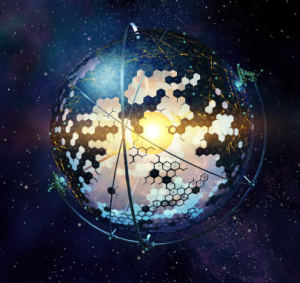 One of the biggest areas of speculation in interstellar science is whether there may be Dyson Spheres somewhere out there in the cosmos. A Dyson Sphere is a giant construct around a star, designed by its creators to capture as much of the star’s energy as possible in order to optimize that civilization’s development and longevity.
One of the biggest areas of speculation in interstellar science is whether there may be Dyson Spheres somewhere out there in the cosmos. A Dyson Sphere is a giant construct around a star, designed by its creators to capture as much of the star’s energy as possible in order to optimize that civilization’s development and longevity.
But if you think about it, a Dyson Sphere is illogical, because it assumes a star is a stable, predictable source of energy—when it really isn’t. And if you want to lengthen the lifespan of your race, building a permanent construct around an essentially unstable star is just about the last thing you want to do.
A star like our sun is a beast of chemicals caught in a constant state of fusion burning. But there is nothing constant about its output, despite the fact that it may seem pretty constant over a few light years away and a few thousand years of observation. In fact, our own observations of the Sun in just the last few decades has revealed irregular and unpredictable outputs, producing more and less energy, radiation and energetic particles all the time. We have found correlations between these irregular outputs and changes to our atmosphere and temperature, impacting ice ages and regional habitability. Studies suggest that we could see even larger irregularities in the future, which could strain our existing planet’s viability significantly.
Besides this irregular output, we know that a star has a limited shelf life. In approximately 5 billion years, the sun will begin the helium-burning process, turning into a red giant star. When it expands, its outer layers will consume Mercury and Venus, and reach Earth. Every other star will similarly burn out at some point, either going nova in the process, or collapsing upon itself, perhaps turning into a black hole.
So, imagine you’re an alien race that wants its species to live forever: Would you commit mind-boggling resources and time to creating a giant habitat around a star that’s only going to die eventually and leave you with a mind-bogglingly huge lifeless shell?
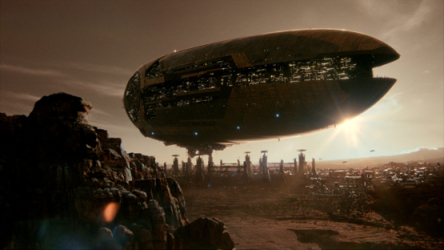 I don’t think so. It would make more sense (and consume a lot less in time and resources) for that alien race to shoot for full mobility, in order to move from star to star as needed. They would become a space-faring race, building either groups-small or populations-large spacecraft and living off space like nomadic tribesmen, transiting to solar systems whose star could provide them energy, and perhaps planets that they could mine for needed resources; and when the star no longer suited them (about to nova or collapse, or simply putting out too many unpredictable flares of energy and particles), they would gather enough energy and resources to sustain them as they head out to the next system.
I don’t think so. It would make more sense (and consume a lot less in time and resources) for that alien race to shoot for full mobility, in order to move from star to star as needed. They would become a space-faring race, building either groups-small or populations-large spacecraft and living off space like nomadic tribesmen, transiting to solar systems whose star could provide them energy, and perhaps planets that they could mine for needed resources; and when the star no longer suited them (about to nova or collapse, or simply putting out too many unpredictable flares of energy and particles), they would gather enough energy and resources to sustain them as they head out to the next system.
This point is so important that it should be added as a variable to the Drake Equation (the formula used to predict the possibility of other intelligent life in the cosmos). One element in the Drake Equation is the state of a world’s habitability. But if you take into account that a race may have evolved and departed a planet or system before it became uninhabitable, then the habitability variable must be expanded to include planets that may at one time have been habitable enough for long enough to spawn a race, even if it is no longer habitable. So habitability becomes a limited span, long enough for a race to develop far enough to be able to leave for a new star system… but that also expands the possible number of habitable planets.
This also suggests that, if a race became star-faring, that they no longer need a single habitable planet… but they will periodically need to replenish some supplies from resources they can potentially find on multiple planets at different times. So a new variable needs to be added: That of a star system with enough accumulated resources to help sustain a transitory race as it moved from system to system. And its resources don’t need to be comprehensive: If a space-faring race can accumulate resources A, B and C in one system, and wait until they transit to another system to replenish resources D, E and F… again, you’ve expanded the number of planets that may support the survival of a civilization.
Such alterations to the Drake Equation would suggest a higher possibility of neighbors out there, perhaps in places we may not have looked before, since they may be able to harvest resources from a wider array of systems than we have previously assumed. Or possibly in transit from one system to another, and not likely to be wasting valuable resources on beaming signals about looking for other races; at least, not until they reach an oasis that will sustain them for long enough to do some local exploring for the next system to transit to.
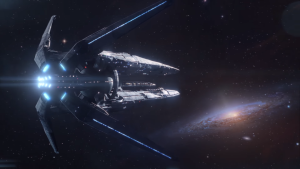 This last point could be potentially interesting, too: For a space-faring race that moves from system to system, harvesting resources as needed, they may someday see the Solar System as a valuable oasis to visit. But for those who are worried that they may feel the need to—I dunno—attack the Earth, subjugate or kill us, and steal our resources… be assured that most of this system’s most valuable resources can be more easily obtained from the many outer planets, moons and asteroids of the solar system, and those resources would not be contaminated with the pesky and unpredictable organic life infesting this planet at present. Because we already know the aliens wouldn’t be big on unpredictability… it makes it much harder and more energy-intensive to survive.
This last point could be potentially interesting, too: For a space-faring race that moves from system to system, harvesting resources as needed, they may someday see the Solar System as a valuable oasis to visit. But for those who are worried that they may feel the need to—I dunno—attack the Earth, subjugate or kill us, and steal our resources… be assured that most of this system’s most valuable resources can be more easily obtained from the many outer planets, moons and asteroids of the solar system, and those resources would not be contaminated with the pesky and unpredictable organic life infesting this planet at present. Because we already know the aliens wouldn’t be big on unpredictability… it makes it much harder and more energy-intensive to survive.
So, I think we can stop looking for Dyson Spheres out there; I doubt there will be many races, capable of building them, who would not be smart enough to know how wasteful they would be. Instead, we should be looking for potential space-oasis systems, and the nomadic ships transiting between them. They may even turn up in our system, respectfully keeping their distance as they harvest resources from the outer planets and try to avoid the locals.


August 24, 2016
Rocket tanks to space habitats
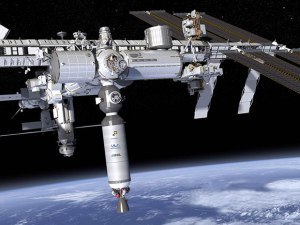 An article in IEE Spectrum describes an idea by NASA contractor NanoRacks to convert spent fuel tanks into habitation modules in orbit.
An article in IEE Spectrum describes an idea by NASA contractor NanoRacks to convert spent fuel tanks into habitation modules in orbit.
This immediately reminded me of an idea I had in my novel Factory Orbit to use spent Space Shuttle fuel tanks (the big orange ones) to fabricate into habitation modules for an orbital factory.
One major difference between the NanoRacks design and my own: My system would join multiple tanks together in a ring and spin them to create artificial gravity for its occupants.
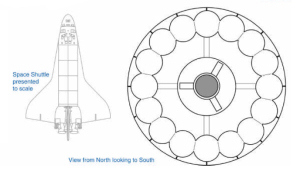 In Factory Orbit, a conglomeration of companies intending to build an orbital factory start by arranging for NASA to carry its spent STS fuel tanks to orbit and leave them in a parking orbit, tethered loosely to each other until needed… sixteen tanks in all, each measuring 153′ length by 27′ diameter.
In Factory Orbit, a conglomeration of companies intending to build an orbital factory start by arranging for NASA to carry its spent STS fuel tanks to orbit and leave them in a parking orbit, tethered loosely to each other until needed… sixteen tanks in all, each measuring 153′ length by 27′ diameter.
When the conglomeration’s astronaut builders were sent to orbit, they cut large openings in two sides of each tank, then joined them in a ring so a person could pass from tank to tank via the large openings. The tanks were welded together and sealed; then an insulating and protective inner layer was added to the interior, and the whole thing was pressurized with air. Temporary airlocks were placed about the inner sides of the ring, allowing the astronauts to enter, remove their suits and construct a habitable interior in a shirtsleeve environment.
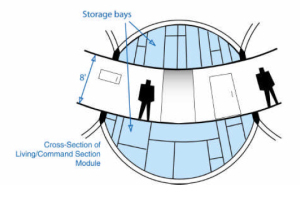 Once the ring was finished, it was brought up to a rotational speed to create a standard Earth gravity (1 gee) inside the ring. The result was a habitat that would function much like the habitation ring in the space station depicted in 2001: A Space Odyssey (though not nearly as large), with two main corridors that encircled the ring, and connecting corridors that gave access to living and working quarters, and engineering and storage areas in the nose and tail of each tank module. This gave workers a fairly comfortable place to rest between shifts of creating their factory, which was nested inside the ring and counter-rotated to provide a 0-gee environment on the factory “floor.”
Once the ring was finished, it was brought up to a rotational speed to create a standard Earth gravity (1 gee) inside the ring. The result was a habitat that would function much like the habitation ring in the space station depicted in 2001: A Space Odyssey (though not nearly as large), with two main corridors that encircled the ring, and connecting corridors that gave access to living and working quarters, and engineering and storage areas in the nose and tail of each tank module. This gave workers a fairly comfortable place to rest between shifts of creating their factory, which was nested inside the ring and counter-rotated to provide a 0-gee environment on the factory “floor.”
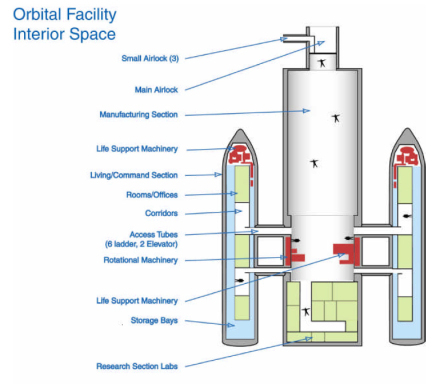 The intent of the orbital factory was to facilitate the manufacturing of products and synthesis of elements that could be made cheaper, purer or more efficiently in a 0-gee environment, or aided by the easily-obtained vacuum of space. The manufacturing area, as well as a research and development area, would maintain a non-rotational 0-gee environment for daily operations round the clock, while the ring of living and command modules would constantly rotate at 1-gee. A series of ladders and elevators would allow access to the non-rotational hub of the manufacturing and research areas, allowing personnel to move from one environment to the other at will.
The intent of the orbital factory was to facilitate the manufacturing of products and synthesis of elements that could be made cheaper, purer or more efficiently in a 0-gee environment, or aided by the easily-obtained vacuum of space. The manufacturing area, as well as a research and development area, would maintain a non-rotational 0-gee environment for daily operations round the clock, while the ring of living and command modules would constantly rotate at 1-gee. A series of ladders and elevators would allow access to the non-rotational hub of the manufacturing and research areas, allowing personnel to move from one environment to the other at will.
This would allow personnel to work in the 0-gee environment during their shift, then retire to the rotating section where their bodies would be back in their natural 1-gee environment, thus mitigating the deterioration on the human body caused by constant exposure to 0-gee, and leading to healthier orbital workers who would have fewer health-related problems upon returning to Earth.
I had this book on the market for a few years, then took it down to update the technology developed on the facility… which I never did to my satisfaction. At this point, the book needs a healthy rewrite anyway… but I maintain the technology behind the facility itself is sound and believable, and could make for an interesting series.





